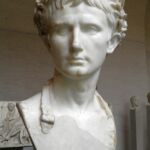The Mausoleum of Augustus was built on the northern edge of the Field of Mars in Rome, on the Tiber, in 29 BCE by Octavian Augustus as a burial place for himself and his family. It is a structure located at the top of an artificial mound, set on a high podium.
The object has the shape of a circle with a diameter of 87 meters and was built of white marble. The structure of the podium consists of five circles centered around a pillar over 40 meters high, which was probably crowned with a bronze statue of the founder, Octavian Augustus. The passage (dromos) led to a corridor between the third and second (from the center) rings. The corridor led to the burial chambers. A place for Augustus’ ashes has been prepared in the center, inside the pillar. Family members, incl. Octavia, Agrippa, Germanicus, Livia, Tiberius, Caligula and Claudius were buried in the burial chamber between the smallest ring of the podium and the pillar.
Naturally, no imperial remains have survived to this day. The ashes were placed in beautifully decorated urns, made of gold or other precious metal, which were interesting prey for everyone. It is suspected that the urns were probably stolen either by the Visigoths (410 CE) or the Vandals (455 CE) during the conquest of Rome or in later times, when the building fell into disrepair. The ashes, in turn, were probably simply spilled.
The entrance to the Mausoleum of Augustus was located on the south side. In front of the entrance, on the sides, there were 2 Egyptian obelisks, one in Piazza dell Quirinale and the other next to the Basilica of Santa Maria Maggiore. The mound itself was covered with earth (perhaps on which cypresses grew) and topped with a bronze statue of the emperor.
The following personalities were buried in the mausoleum: Octavia the Elder (under 29 BCE), Marcus Claudius Marcellus in 22 BCE, Marcus Agrippa in 12 BCE, Octavia the Younger in 11 BCE, Druzus the Elder in 9 BCE, Lucius Julius Caesar in 2 CE, Gaius Julius Caesar in 4 CE, Octavian August in 14 CE, Germanicus in 19 CE, Drusus the Younger in 23 CE, Livia Druzylla in 29 CE, Agrippina the Elder in 33 CE, Claudius Nero Julius Caesar in 31 CE, Tiberius in 37 CE, Caligula in 41 CE, Claudius in 54 CE, Britannicus in 55 CE, Poppaea Sabina in 65 CE, Nerva in 98 CE and Julia Domna in 217 CE.
After the fall of Rome, the mausoleum was used for many centuries for various purposes: as a fortress, theatre or concert hall, which meant that the building lost its original appearance, among others. the main burial chamber and darkened corridors have not survived to our times, and now the center of the mausoleum is an empty square with a rotunda built on the orders of Mussolini. It is worth noting that it was not until the 20th century, during the reign of Mussolini, that it was decided to remove the lush vegetation that concealed the monument. The mausoleum has recently undergone a significant renovation, which allowed the interior to be made available to visitors.








